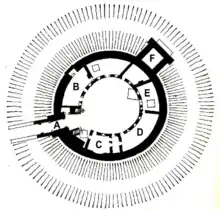Shell keep
A shell keep is a style of medieval fortification, best described as a stone structure circling the top of a motte.

In English castle morphology, shell keeps are perceived as the successors to motte-and-bailey castles, with the wooden fence around the top of the motte replaced by a stone wall. Castle engineers during the Norman period did not trust the motte to support the enormous weight of a stone keep. A common solution was to replace the palisade with a stone wall then build wooden buildings backing onto the inside of the wall. This construction was lighter than a keep and prevented the walls from being undermined, meaning they could be thinner and lighter.
A gazetteer compiled by archaeologist Robert Higham counted 21 shell keeps in England and Wales.[1] Examples include the Round Tower at Windsor Castle[2][3] and the majority were built in the 11th and 12th centuries.[4]
 The shell keep of Windsor Castle was built by Henry II and remodelled in the 19th century.
The shell keep of Windsor Castle was built by Henry II and remodelled in the 19th century. Restormel Castle built around the motte
Restormel Castle built around the motte Plan of Restormel Castle
Plan of Restormel Castle
Notes
- Higham 2016, p. 63.
- Pettifer 2002, p. 7.
- Darvill, Stamper & Timby 2002, p. 196.
- Hislop 2013, p. 96.
References
- Darvill, Timothy; Stamper, Paul; Timby, Jane (2002). England: an Oxford archaeological guide to sites from earliest times to AD 1600 (illustrated ed.). Oxford University Press. p. 196. ISBN 0-19-284101-7.CS1 maint: ref=harv (link)
- Higham, Robert (2016), Shell-keeps revisited: the bailey on the motte? (PDF), Castle Studies Group

- Hislop, Malcolm (2013). How to read castles. London: Bloomsbury Academic. ISBN 9781472521613.
- Pettifer, Adrian (2002). English Castles: A Guide by Counties (illustrated ed.). Boydell & Brewer. p. 7. ISBN 0-85115-782-3.CS1 maint: ref=harv (link)